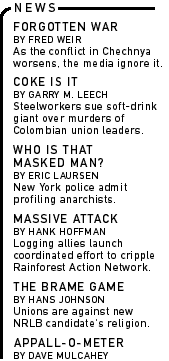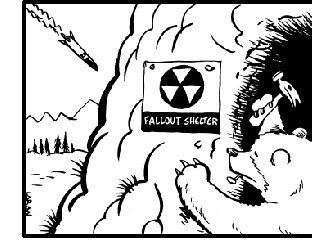|
|

|

|

|
|
|
| |
|
|
|
The Kodiak Launch Complex was marketed to Alaskans as one of the nation's first commercial space ports. Many promises were made to lure public support: High-paying, year-round jobs. Better roads. A fancy cultural center. New schools with real astronauts helping out in the classrooms. Peace and prosperity. The whole multibillion-dollar project, located on Narrow Cape, a remote tip of Kodiak Island 250 miles west of Anchorage, was supposed to be run by a state-chartered outfit called the Alaska Aerospace Development Corporation. In 1996, the state and the feds turned over 3,500 acres of public land for the project, which would house two launching pads, a space vehicle assembly plant, a radar station, a command center and other support facilities. Its backers claimed that a new age of commercial space traffic was dawning, and that Kodiak Island was one of the world's best locations for "launching telecommunications, remote sensing, and space science payloads" into orbit. Local skeptics weren't thrilled at the prospect of their wilderness redoubt being
These concerns were briskly swept aside by state and federal officials. A brief environmental analysis was slapped together, with much of the data concealed from public scrutiny, and construction began in 1998. Not long thereafter, the Alaska Aerospace Development Corporation announced it was having financial problems, and the federal government came to its rescue with a timely handout and the promise of sustained appropriations. But there was a catch: Instead of sending into orbit commercial satellites and the cremated remains of rich Trekkies, the Kodiak site was going to work very closely with the Air Force and its legion of defense contractors. There's some compelling evidence that this was the plan all along, starting with the man tapped to head the Alaska Aerospace Development Corporation: Pat Ladner, a former Air Force lieutenant colonel who served in the '80s as the program manager for a secretive project called the Single Stage Rocket Technology Program (SSTR). This program was a component of the initial burst of funding for Reagan's version of Star Wars. But by the early '90s, with public and congressional support lagging, the Pentagon made a decision to "privatize" much of the development and testing for many of its Star Wars projects. Ladner retired from the Air Force in 1993 and joined the Alaska Aerospace Development Corporation. The facilities at Kodiak were designed by the Defense Advanced Research Project Agency, the same shadowy wing of the Pentagon that had supervised the SSTR program on Ladner's watch. So the launching pads at Narrow Cape turned out to be just another off-shoot of the National Missile Defense program. On November 5, 1998 the Kodiak site fired off its first rocket, an experimental Air Force missile that is part of the Pentagon's "atmospheric interceptor technology program." The rocket arced across the sky for more than 1,000 miles before slamming into the Pacific somewhere off the southern Oregon coast. A second rocket was launched from Kodiak on September 15, 1999. Since those initial launches, a steady stream of Star Wars experiments have been ongoing at Kodiak, projects steered there by the guiding hand of Sen. Ted Stevens, the ranking member of the Appropriations Committee. Stevens is a master at manipulating the flow of federal dollars back to military projects in Alaska, often as last-minute amendments to Defense Supplemental Appropriations bills, where they receive little public scrutiny. This is how Star Wars has continued almost uninterrupted since its inception in 1983. The next round of tests at Kodiak will involve a much more potent and unnerving rocket, a Polaris missile packed with a payload of simulated nuclear warheads. Sometime in August, a Polaris will be fired from Kodiak and streak 4,300 miles to Kwajalein Atoll in the Marshall Islands of the South Pacific, where interceptor missiles will try to shoot it down. Over the next five years, Kodiak is slated to launch more than 20 Polaris rockets. (The other Polaris launching site is on the Hawaiian island of Kauai.) Even though the test rockets only pack simulated nukes, they are still dangerous. The missiles' three-stage booster engines carry highly toxic materials, including magnesium, hydrazine and radioactive thorium. The boosters fall to the ocean and are not recovered. The exhaust trail itself leaves behind a poisonous plume of smoke. "Each rocket first stage releases a minimum of 8,000 pounds of aluminum oxide at lift-off," warns Brad Stevens (no relation to the senator), a biologist with the National Marine Fisheries Service in Kodiak. "Much of this will wind up in local streams that drain into Twin Lakes and the Fossil Beach tidepools and kelp beds, which provide nutrients and shelter for juvenile marine species. Documented fish kills in waterways around Cape Kennedy attest to the fact that rocket emissions can destroy aquatic life." (Also under the flight path of the missiles are rocky beaches on small islands that serve as haul-outs for Stellar sea lions, an endangered species.) One of the launch trajectories will send missiles over the fishing villages of Akhiok and Old Harbor and across one of the world's most pristine salmon spawning grounds. The Pentagon has told the people living there not to worry: They will clear the waters of boats before each launch and build two hardened bunkers in each town. The bunkers serve as stark reminders that the townspeople not only are potential victims of an accident, but a target of Russian and Chinese defense systems designed to counter Star Wars. Alaskans are old hands at this by now. Indeed, there's a grim irony in the fact that Alaska, the most frigid of states, has been one of the most ravaged battlegrounds of the Cold War. Over the past 55 years, Alaska has witnessed: early warning radar erected onto the fragile tundra in the early '50s; the intentional irradiation of more than 100 unwitting Alaskan native peoples in 1955 to test the acclimation of humans to sub-zero temperatures; Project Chariot, a mad scheme to excavate a naval harbor at Cape Thompson by exploding five nuclear bombs at the mouth of a coastal creek (the bombs were never detonated, but the site was left a toxic and radioactive mess); and the Cannikin nuclear test in 1971, one of the largest ever, which permanently contaminated Amchitka Island and continues to ooze radioactive debris into the Bering Sea. Kodiak alone already suffers from 17 toxic dumps left by previous Pentagon operations on the island. Even the push to transform the Arctic National Wildlife Refuge into a forest of oil derricks has lately been justified on the grounds of national security. So it shouldn't come as much of a surprise that Alaska seems poised to bear the brunt of Bush's new Star Wars plan. The Kodiak site is just one of more than a dozen enclaves of assorted anti-missile paraphernalia that will be scattered across the state, from the Aleutians to the Arctic plains. In addition to Kodiak, Congress approved the construction of a $500 million radar dome on remote Shemya Island in the Aleutians. Shemya, the site of an old CIA listening post, is more than 1,500 miles from the nearest active military base. A top Pentagon official told the Washington Post that it posed difficult construction problems, and that when completed the site would be "very, very vulnerable" to attack. Ted Stevens also has pushed to make Fort Greely Military Reserve, an Army outpost on the Tanana River about 90 miles southeast of Fairbanks, a base for the 100 interceptor missiles once the Stars Wars scheme becomes operational. Constructed in 1945, Fort Greely already has a dark history as a kind of outdoor laboratory for some of the Army's most malign experiments. In 1953, the Army authorized the use of Fort Greely and the adjacent Gerstle River Proving Ground to test chemical and biological weapons. Of course, these operations were kept secret from the surrounding population of homesteaders, miners, trappers and the Goodpastor tribe of Athabaskan Indians. In the early '60s one of the biological weapons tests went terribly wrong, and 21 people were infected with tularemia. After the Army stopped testing chemical and biological weapons at the site, it did a cursory cleanup and buried most of the contaminated canisters and shell-casings in shallow pits next to the river and several lakes and ponds, where the lethal detritus continues to seep out. In 1962, the Army built a small nuclear reactor at Fort Greely, which it claimed was needed as a power station. This claim proved to be an elaborate cover. The reactor did generate some electricity, but it also produced weapons-grade plutonium. The background of this project is revealed in a startling report released last year by physicist Norm Buske and Pam Miller, director of Alaska Community Action on Toxics. Among their findings: The Army dumped nuclear waste into Jarvis Creek for 10 years; disposed of liquid radioactive waste into groundwater that was used as a drinking source by the village of Clearwater; and used radioactive steam from the reactor to heat the military base. "Army leaders were more committed to producing special nuclear materials for battlefield nuclear weapons than they were to assuring the safety of the operation," Buske and Miller concluded. Fort Greely was slated for decommissioning as part of the military's base-closure program. A convincing theory holds that Stevens and the Pentagon want to transform this Arctic outpost into the deployment site for 100 interceptor missiles as a convenient way to disguise the extent of the contamination and to evade accountability for what went on up there through the '60s. What's more, Fort Greely site is a major sticking point with the Russians and Chinese. Under the Anti-Ballistic Missile Treaty, each nation is permitted only one site for missile defense. Currently, the U.S. site is in Grand Forks, North Dakota. Plans to begin pouring concrete for the new site at Fort Greely clearly violate the accord. Stevens, Alaska's senior senator, dismissed concern that these early Star Wars projects might breach the treaty, saying, "Construction of the Shemya radar in and of itself is not a violation of the ABM treaty until it is integrated into a defense system." Why Alaska? It's not that all Alaskans welcome the Pentagon. In fact, an organized campaign defeated Edward Teller's nightmarish Project Chariot scenario. And in 1983, Alaskans approved the nuclear freeze initiative by an overwhelming vote. But in a state this large and sparsely populated it's relatively easy for big money to overwhelm citizen opposition, especially when those billions are backed by the lobbying might of the military, the nuclear labs and their contractors. At present estimates, the Star Wars program will unleash a $60 billion spending spree. In Republican Sens. Frank Murkowski and Stevens, Alaska sports two pitiless hoarders of Pentagon pork. Even Alaska's Clintonesque governor, Democrat Tony Knowles, has gotten into the act, investing a chunk of state money with lobbyists to help steer as much of the Star Wars business to Alaska as possible. It will surprise no one who is familiar with the symbiotic relationship between Stevens and the arms makers that the treasurer of his Northern Lights Leadership PAC, Richard Ladd, is also president of Robinson International, a top D.C. lobby shop that specializes in representing defense contractors. In the past two election cycles, the Northern Lights PAC has raked in more than $300,000, largely from corporate executives, many with ties to defense firms. The PAC recycled all that money back into Republican campaigns. In return, the defense companies, led by Boeing and Lockheed-Martin, have been very generous to Stevens. From 1995 to 1999, the senator received $255,650 in PAC contributions from missile defense-related firms, second only to Virginia's John Warner, who, as head of the Senate Armed Services Committee, pulled in $330,000. Earlier this year, in an interview with the Alaska Journal of
Commerce, Stevens boasted about how he almost single-handedly
had steered hundreds of millions of dollars in defense contracts
to Alaska, even under President Clinton. He predicted that much
more federal loot was ready to flow north in the Bush regime. The
money comes in, but it doesn't stay long. Most of it ends up in
corporate coffers in Alabama, California and Washington State. Even
Ladner, the head of the Alaska Aerospace Development Corporation,
recently admitted that the year-round jobs at the Kodiak launch
site would probably only amount to a few security and maintenance
positions. It's the old Cold War routine repeated once again: The
money goes south, but the risk and the waste stays up in Alaska.
|






